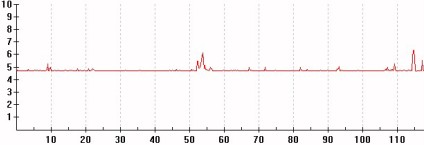![]()
![]()

![]()
![]()

(aka "Songs From the Second Floor" or "Sange fra anden sal" or "Sanger fra andre etasje")
directed by Roy Andersson
Denmark / Sweden / Norway 2000
|
Like the red-eye passengers in The Langoliers, the people in Songs From The Second Floor exist in a dead moment in time. They inhabit a city full of people, where creativity, imagination and beauty have fled; their world is passing on, even if they are not. The stock market has crashed, religion is dead, everyone wants to leave (both literally and metaphorically), social order is starting to break down, and all anyone wants to do is wait for it to pass. It is a startling vision from Swedish filmmaker Roy Andersson that took four years to make, and it represents a perfect marriage of theatre, cinema and pure art. Songs From The Second Floor is more of a sustained mood than a film. There are plotlines worth following and characters to get to know, but they are secondary to Andersson’s mise-en-scene. His absolute creative control shows in every carefully constructed scene; each detail down to the hue of the sun in the background is complementary to the surroundings and action. Andersson’s city looks like any other featureless downtown core, but feels like a dream. Whole streets are devoid of people while others have traffic jams winding into infinity. Hordes of businessmen wander in packs, flagellating themselves as they roam. Others gaze into crystal balls to discern some iota of hope. A salesman tries to rejuvenate his business by selling models of Jesus on the Cross. When his endeavour fails, he stares at the crucifix and asks, “Who could ever hope to profit from a crucified loser?” A group of stockbrokers is so far out of touch with reality that they could swear they are seeing the house across the street move. The owner of a furniture store torches everything to get the insurance money, finding nothing left in his life for which to care. He’ll encounter some ghosts, but by the end it becomes difficult to tell whether the living or the dead are better off. |
Posters
 |
 |
Theatrical Release: May 2000 (Cannes Film Festival)
Reviews More Reviews DVD Reviews
DVD Review: New Yorker - Region 1- NTSC
| DVD Box Cover |
|
CLICK to order from: |
| Distribution | New Yorker Video - Region 1- NTSC | |
| Runtime | 1:58:04 | |
| Video | 1.78:1
Original Aspect Ratio Average Bitrate: 4.79 mb/s NTSC 720x480 29.97 f/s |
|
|
NOTE: The Vertical axis represents the bits transferred per second. The Horizontal is the time in minutes. |
||
| Bitrate:
|
|
|
| Audio | Swedish (Dolby Digital 2.0 Stereo) | |
| Subtitles | English, None | |
| Features |
Release Information: Studio: New Yorker Video Aspect
Ratio: Edition Details: |
|
| Comments: |
This is a stacked DVD from New Yorker - Directors Commentary, Deleted Scenes, Anamorphic etc. I understand that director Roy Andersson was paramount in the production of this DVD, being unhappy with the current ones available (audio drop-out in the Alliance Atlantis - Region 1- version). Not as bright and clear as one might expect from a new film, I understand this is exactly how the film looked at Cannes and the slight greenish tinge is intentional.
The subtitles are clear
and unobtrusive, the aspect ratio is maintained and anamorphic , there
is some visible film grain... all good and New Yorker deserves high
marks indeed.
|
DVD Menus
 |
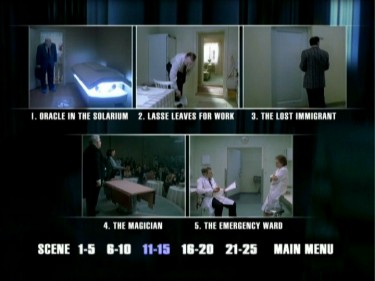 |
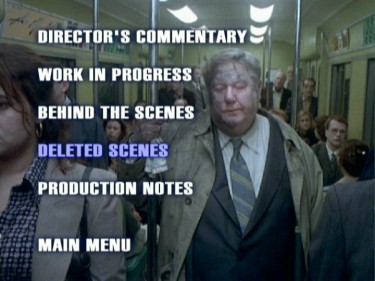 |
 |
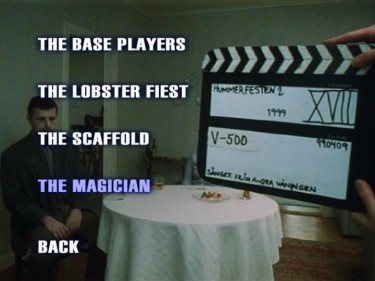 |
 |
Subtitle Sample
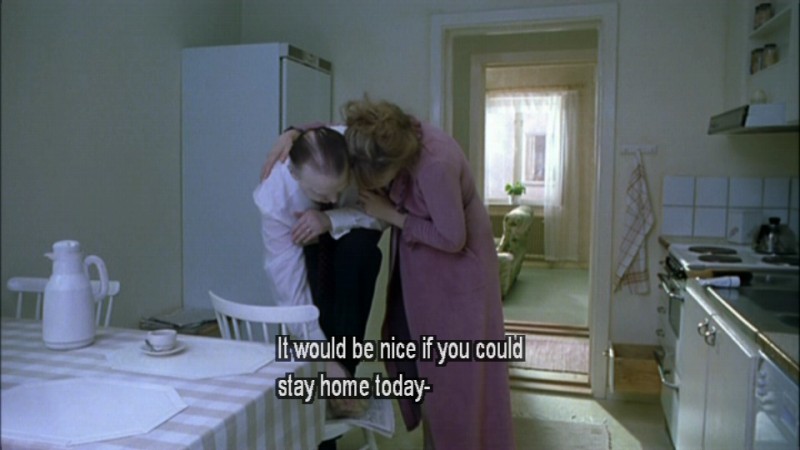 |
Screen Captures
 |
 |
 |
 |

